If you are getting into the world of cooking, then you might get a lot of suggestions regarding your cookware. The most popular one is to go for metal pans and pots.
Amidst all these recommendations, it is only normal to be confused about the particular metal cookware that you should go for. Having too many options in the market does not make the task of selecting any easier.
Normally, chefs and cooks go for steel, aluminum, or copper cookware. But, that is not enough to know which one would be best to use.
Therefore, we are here to provide you with ample information regarding all of the materials and the kind of cookware that they make.
Stainless Steel Cookware
If you are familiar with the term ‘stainless steel,’ then you are surely aware of how useful and amazing the metal is. It can be used to make various tools, one of which happens to be cookware.
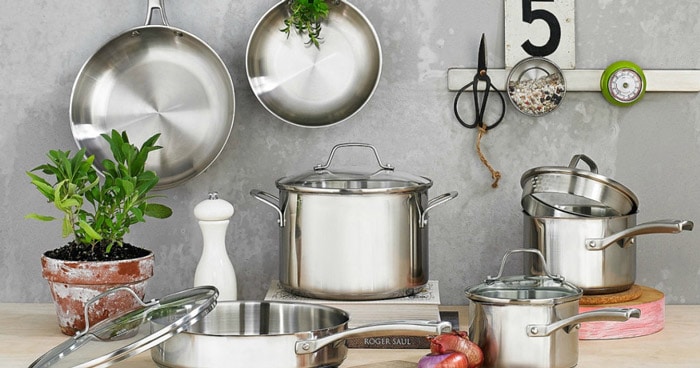
Highly Resistant to Rust and Scratches
So, what is steel exactly? It is a metallic alloy made of chromium and iron. While iron is very reactive and prone to rust, chromium knows how to keep it protected.
Hence, chromium reacts with the oxygen in the air, forming a hard and impermeable layer on the surface of the metal. This prevents the entrance of moisture.
As a result, the pots and pans will remain protected from rust and scratches. The layer will never chip off, and the pan will never crack. Overall, it makes durable cookware, which will not need to be replaced in a long time.
Easy to Clean
The other advantage of this is that you will not have to be too careful when scrubbing your stainless steel cookware. You can be as harsh with them as you want, and they will remain intact.
Moreover, they are also dishwasher safe. So, you will not face much trouble when cleaning them up. You can use abrasive products to clean the pans, as well.
Prone to Hot Spots
However, food might stick a lot often to the surface of the cookware. As a result, you will have to do a lot of scrubbing frequently, if not on a regular basis.
That is because some thin layered or basic stainless steel cookware is prone to hot spots. Due to uneven heat distribution, food might get scorched or get cooked unevenly.
To avoid this phenomenon, a lot of steel pans come with a layer of copper or aluminum in them. While this enhances their durability, it also causes heat to spread more evenly across the pans.
Safe to Use in Both Ovens and Stoves
They are also safe to use in ovens. Whether we are talking about copper/aluminum layered pans or the basic ones, they can all handle a temperature of about 500F in the oven.
It doesn’t matter whether you use them in the oven or on a stove; their attractive appearance will never fade. They can be brushed for a matte body, or you can let them stay shiny for a reflective surface.

Lightweight
Speaking of which, they are quite lightweight as well. Hence, you can easily wash, transport, or store them. Your hands will not be strained by constantly moving or tossing them around.
Non-Reactive
However, the best attribute of this cookware is that it is non-reactive. Acidic ingredients will not react with them; rather, the food’s flavors will be preserved. All in all, serving you a delicious meal.
Uneven Heat Distribution
But, since it does not transfer heat properly across every point of the pan, it takes quite some time to heat up. Of course, this can easily be avoided by a copper or aluminum layer in the cookware. But, such pans are quite the expensive ones.
Pros
- This cookware is rust, corrosion, and scratch-resistant
- Long-lasting and requires no hassle of being replaced anytime soon
- The pans and pots are dishwasher safe and can be scrubbed carelessly
- They can be used in ovens
- Attractive appearance
- Lightweight body
- Preserves the flavors of ingredients
Cons
- Uneven heat distribution across pans
- Prone to hot spots, which makes food stick to them
- Takes a long time to heat up
- Copper or aluminum layered pans are expensive
Aluminum Cookware
Looking for affordable cookware that performs remarkably well? In that case, take a look at aluminum pans. They are quite popular in restaurant kitchens, as well as at homes.
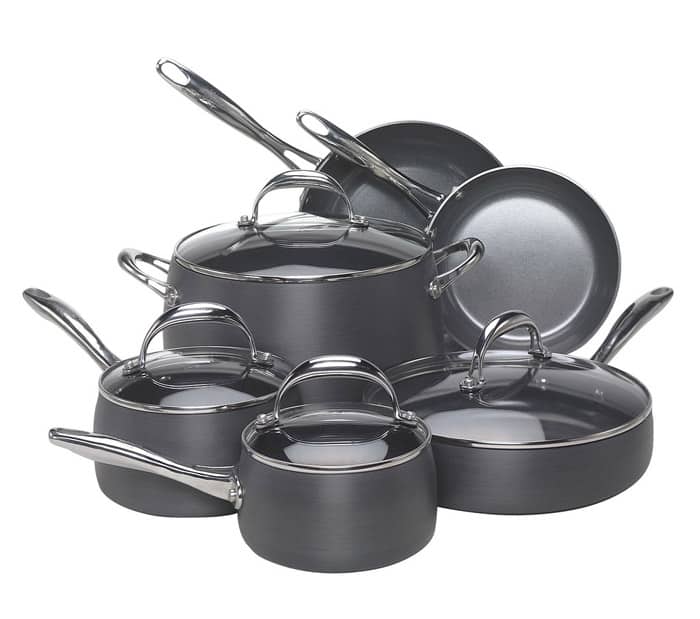
Excellent Conductivity of Heat
One of the major reasons behind its popularity is its commendable heat conductivity. Aluminum heats up very quickly, which gives its users better control of the temperature.
But that’s not all. Aluminum pans are capable of distributing heat evenly across the surface. Hence, you will not have to move the cookware a lot often on the stove to avoid hot spots. Your meals will cook evenly at all times, without all that effort.
Moreover, the cookware cools down quite quickly as well. So, you can wash it without burning your hands soon after you are done with your cooking.
Hard-Anodized Pans Are Tough
Some aluminum pans are hard-anodized, whereas others are not. You should choose the hard-anodized ones because they enhance the features of aluminum cookware.
For instance, such pans are very tough. They have a hard exterior, which is very resistant to scratches. You can scrub them carelessly or use any utensils of your choice, only to find their surface intact, without scratches.
Cannot Be Dish-Washed
However, these pans are not dishwasher friendly. So, it is always preferable to wash them with your hands. Although, the task won’t be too hard, considering how food doesn’t stick on the surface.
Hard-Anodized Pans Don’t React with Acidic Elements
On the other hand, being hard-anodized also makes sure the pan does not react with acidic or alkaline ingredients. Recipes, including citrus, tomatoes, or any other acidic substance, will be safe to cook in these pans.
Non-Anodized Cookware Is Reactive and Short-Lasting
If the cookware remains non-anodized, then they will be prone to reacting with acidic ingredients. This will cause your meals to taste metallic, and it is not good for your health as well.
The reaction might as well damage your cookware. As a result, after a few months of usage, you may not be able to cook on it anymore. Hence, the pans must be hard-anodized.
Non-Stick Surface
Are you worried about your pans chipping? Well, with aluminum cookware, that will not be a matter to fret about anymore. These pans don’t include a non-stick coating. That is because they can provide features similar to that of a non-stick surface without having the coating itself.
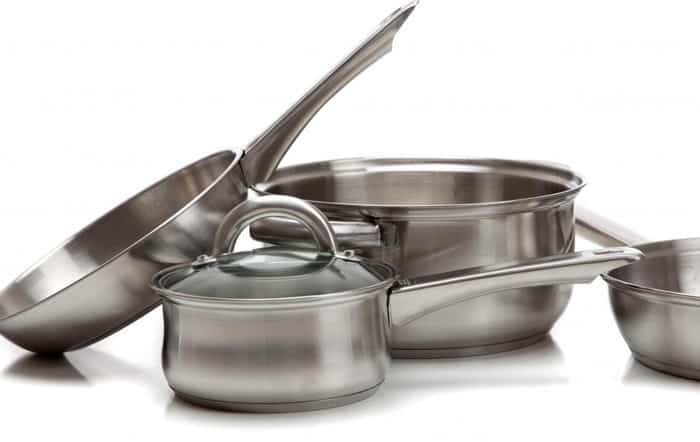
Affordable
And the best part is? You can get all of this at an affordable price range! However, the hard-anodized pans are a little more costly than their non-anodized versions.
Pros
- Commendable heat conductivity
- Cooks evenly and avoids hot-spots
- Hard-anodized aluminum pans are scratch-resistant and tough
- The hard-anodized versions don’t react with acidic ingredients
- Has a non-stick surface without the coating
- Very affordable
- The hard-anodized pans are long-lasting
Cons
- Hard-anodized aluminum cookware is costly
- Cannot be dish-washed
- Non-anodized pans are reactive with acidic elements
- The non-anodized versions warp easily and don’t last long
Copper Cookware
Widely known for excellent thermal conductivity, copper cookware is not one to disappoint. This aspect of copper makes it a suitable material for many tools. Starting with wires to electronics, the uses of this metal are diverse.
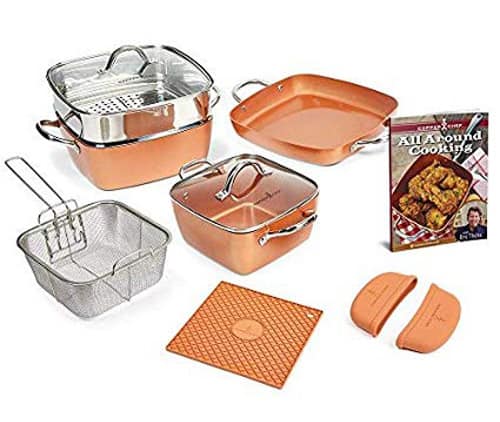
Superior Conductivity of Heat
Along with being a remarkable heat conductor, copper can also conduct electricity. Hence, it is quite a popular material, having high demand in the market.
So, thanks to its superior conductivity, copper pots and pans can heat up pretty quickly. As soon as you put them on a burner, you will notice that the entire cookware has heated up evenly.
This feature allows food to cook uniformly while avoiding burns at all times. So, the cookware is mostly used to make sauces and candies. In fact, despite reaching high temperatures, food will never stick to it.
Anti-Bacterial
Moreover, since copper is anti-bacterial, microorganisms such as bacteria or germs don’t tend to survive on the cookware. As a result, your food will always be fresh and healthy with these anti-bacterial pans.
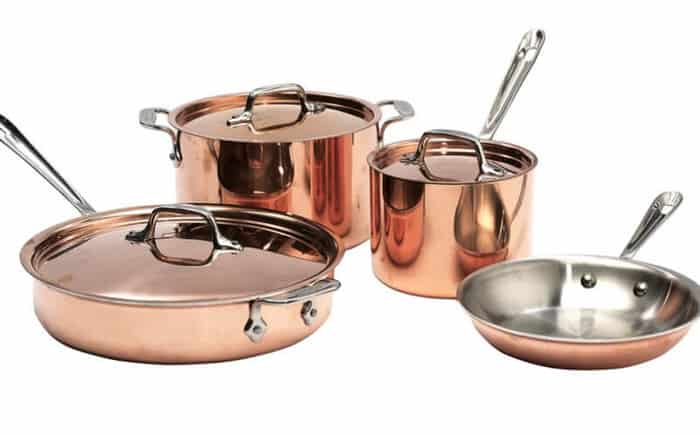
Highly Reactive
But, here’s the catch. Acidic and alkaline elements shouldn’t directly contact copper, as that might cause a reaction. Similarly, if such ingredients are cooked on bare copper pots, then a metallic taste might get infused into the meals.
Furthermore, other ingredients are not safe on bare copper either. Such cookware might leave a grey streak on meals. So, you will be getting a metallic taste nonetheless.
Stainless Steel or Tin Linings Are Necessary
To avoid this problem, copper pans are lined with tin or stainless steel. They are both popular options, but, for longevity, you should go for a stainless steel coating. With tin, on the other hand, you will have to reline the pans every five years.
This coating changes color over time; it develops a patina. As a result, the surface of the cookware becomes harder, which keeps them durable and rust-resistant for a longer period.
Difficult to Clean and Polish
However, if you don’t want this change in color, then you can regularly polish and maintain your cookware. That will help maintain the pan’s attractive appearance.
But, cleaning copper cookware is no easy task. You will have to be very careful when washing or scrubbing them. They cannot be dish-washed, and you can never use detergent to clean them. Even the best copper bottom cookware has this issue.
Wooden/Metal Spatulas and Glass Top Stove Cannot Be Used
Speaking of which, using metal or wooden utensils on copper cookware is not a good idea. These pans can easily be scratched. So, you can only use Teflon coated spatulas with them.
Also, you cannot use them on ceramic glass top stoves. They will leave metallic marks all over the stove; hence, it’s better to avoid using them together.
Expensive
Copper tools are generally known to be expensive. And their cookware counterparts are no different. Whether they are talking about red copper cookware or the stainless steel lined ones, they are all very costly.
Pros
- Heats up quickly and cooks food uniformly
- Great temperature control
- Lined with tin or stainless steel for safety
- Develops a patina over time
- Has an attractive appearance with proper maintenance
- Works best with sauces and candies
- Anti-bacterial
Cons
- Reacts with acidic or alkaline ingredients
- Scratches easily
- Cannot be used on glass top stoves
- Very expensive
Choose The Best One
Picking the best cookware among copper, stainless steel, and aluminum is going to be tough. All of these three materials offer some amazing features, along with a few flaws.
Stainless Steel Requires Little Maintenance and Is Safe
Stainless steel cookware is a must-have at every home kitchen. They come at various price ranges, which allows its users to choose from multiple options. Despite the difference in costs, they will never fail to shine.
Moreover, they require little maintenance, which makes dealing with them hassle-free. But, they do fail to provide uniform heat distribution, unless they are layered with copper or aluminum.
They don’t react with acidic or alkaline ingredients while preventing rust and scratches at all times. So, you can try diverse recipes on them. All these aspects set it apart from aluminum and copper cookware.
Aluminum Is Affordable and a Good Conductor of Heat
Aluminum cookware is usually affordable. They provide even heat distribution, and you can always avoid hot spots with them. But they can warp and scratch easily, which makes it necessary for them to be anodized.
They also react with acidic foods. And the pans cannot be dish-washed at all. These features are somewhat similar to copper.
Copper Is an Excellent Conductor of Heat
Except, copper is really expensive, and no cookware can match it in terms of heat distribution. You will often see chefs and cooks treating copper pans as a luxury item, and you can already tell the reason behind it.
Copper cookware cannot be used regularly, and they need a lot of care and maintenance to remain intact over the years. Dealing with them is quite hassle-some, but the results they produce surely makes the trouble worth it.
Ultimately, any metal cookware can be the best one for you, depending on what you are looking for.
Final Words
It is only normal to be confused when choosing the best among the three. But, for regular use, you can go for stainless steel or aluminum cookware. Although stainless steel will need a little less maintenance than aluminum pans.
On the other hand, copper cookware is mostly used to prepare special dishes. So, if you want cooking sets that are perfect for occasions, then these should be your go-to.

